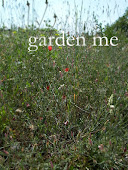Sto cercando di scrivere un'introduzione a queste pagine e mi accorgo, ora che e' sera, come la piu' semplice introduzione sarebbe invitare a guardare il film "Priona", mentre la piu' personale sarebbe invitare a leggere "garden me". Infine una terza, quella che scelgo: perdersi in giardino.
Voglio condividere cio' che so a proposito del fare un giardino, le piante ed il senso di luogo che con esse comincia, le loro comunita' ed il paesaggio, quello piu' aperto, cui il giardino e' sempre affezionato.
Il seme di mela che piantavo nel giardino dell'asilo era gia' un frutteto che nasceva come il seme di Elze'ard Bouffier quando, nel segno che si anima, prende forma dalla mano che tocca il terreno. Il presente del giardino parte dalla voglia di mettere le mani nella terra. Solo cosi' un parco costruito sul tetto di un parcheggio viene restituito al nostro diritto di pensarlo per sempre, fossero anche solo venti anni.
Come tenere insieme le cose? Questo fa il giardiniere, che nell'800 poteva anche essere un maggiordomo, aveva buoni occhi e amava le piante e non si inoltrava granche' fuori del piacere del fare, come gli uccelli non si preoccupano del muro di confine del giardino nel posarsi sul ramo. E' di questo fare che le immagini e i testi qui raccontano.
Copiare, copiare ed ancora copiare cio' che la natura fa e sempre questa copia sara' un'invenzione perche' sempre si ha il piacere di dimenticare qualcosa. Daltronde si parla di un giardino dove si ritorna a casa da lontano e si ritrova quell'albero che e' la somma di tutti gli alberi, come un albero visto da lontano.
Ecco perche' le immagini qui raccolte si sfocano appena le si guarda. E' perche' le piante si muovono nella nostra testa, non riescono a non rincorrersi, tra adesso e prima, prendendo gli spazi piu' facili dove radicarsi, come nei fossi e correre fino al mare.
Iscriviti a:
Post (Atom)
................................................
Ecological Planting Design
Ecological Planting Design
What do these words mean? Some principles of ecological planting design. (from the book: "A New Naturalism" by C. Heatherington, J. Sargeant, Packard Publishing, Chichester)
Real structural plants marked down into the Planting Plan. The other plants put randomly into the matrix: No. of plants per msq of the grid, randomly intermingling (even tall plants). Succession through the year.
Complete perennial weed control.
High planting density. Close planting allows the plants to quickly form a covering to shade out weeds.
Use perennials and grasses creating planting specifications that can be placed almost randomly.
Matrix: layers (successional planting for seasonal interest) of vegetation that make up un intermingling (random-scattering) planting scheme: below the surface, the mat forming plants happy in semi-shade, and the layer of sun-loving perennials.
Plants are placed completely randomly: planting individual plants, groups of two, or grouping plants to give the impression of their having dispersed naturally. Even more with the use of individual emergent plants (singletons) that do not self-seed, dispersed through the planting.
An intricate matrix of small plants underscores simple combinations of larger perennials placed randomly in twos or threes giving the illusion of having seeded from a larger group.
The dispersion effect is maintained and enhanced by the natural rhythm of the grasses that give consistency to the design. They flow round the garden while the taller perennials form visual anchors.
Allow self-seeding (dynamism) using a competitive static plant to prevent self-seeders from taking over: Aruncus to control self-seeding Angelica.
Sustainable plant communities based on selection (plants chosen for their suitability to the soil conditions and matched for their competitiveness) and proportions (balance ephemeral plants with static forms and combinations such as clumpforming perennials that do not need dividing: 20% ephemeral, self-seeding plants, 80% static plants) of the different species, dependent on their flowering season (a smaller numbers of early-flowering perennials, from woodland edges, which will emerge to give a carpet of green in the spring and will be happy in semi-shade later in the year, followed by a larger proportion of the taller-growing perennials which keep their form and seed-heads into the autumn and the winter).
Year-round interest and a naturalistic intermingling of plant forms.
Ecological compatibility in terms of plants suitability to the site and plants competitive ability to mach each other.
Working with seed mixes and randomly planted mixtures.
Perennials laid out in clumps and Stipa tenuissima dotted in the gaps. Over the time the grass forms drifts around the more static perennials and shrublike planting while the verbascum and kniphofia disperse naturally throughout the steppe.
Accents: Select strong, long lasting vertical forms with a good winter seed-heads. Select plants that will not self-seed, unless a natural dispersion model is required.
Planes: if designing a monoculture or with a limited palette, more competitive plants may be selected to prevent seeding of other plants into the group.
Drifts: to create drifts of naturalistic planting that are static in their shape over time use not-naturalizing, not self-seeding, not running plants.
Create naturalistic blocks for the seeding plants to drift around. For the static forms select plants that do not allow the ephemerals to seed into them.
Blocks: use not-naturalizing species, in high densities, in large groups.
Select compatible plants of similar competitiveness to allow for high-density planting (to enable planting at high density in small gardens).
Achieve rhythm by repeating colours and forms over a large-scale planting.

